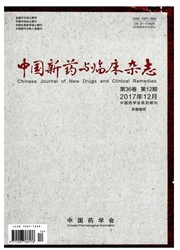

 中文摘要:
中文摘要:
目的探讨缬沙坦对高糖诱导肾小球足细胞活化T细胞核因子2(NFAT2)活化及细胞凋亡的影响。方法将分化成熟的足细胞分组给予不同糖浓度、不同干预时间、NFAT2抑制剂11R.VIVIT、NFAT2活化剂ionomycin等刺激,采用Westernblot检测足细胞胞核中NFAT2的表达水平、流式细胞仪检测足细胞凋亡情况。结果高糖能刺激足细胞NFAT2活化入核。20mm01.L—t葡萄糖作用2h时NFAT2活化入核达到高峰;这与Ionomycin作用相似,两者刺激下的NFAT2的表达水平无显著差异(P〉0.05)。缬沙坦、11R—VIVIT与高糖共同刺激下,足细胞核中NFAT2的表达水平低于单纯高糖刺激(P〈0.01).而缬沙坦和11R—VIVIT作用无显著差异(P〉0.05)。20InlTlo-1葡萄糖作用48h时,足细胞凋亡率为(21.47±6.24)%,高于5.3mmol·L-1葡萄糖作用48h[(12.27±1.31)%,P〈0.051,缬沙坦与高糖共同剌激下,足细胞凋亡率低干单纯高糖刺激(P〈0.01),与11R—VIVIT和高糖共同剌激下的凋亡率无显著差异(P〉0.05)。结论缬沙坦可能通过抑制高糖诱导的足细胞NFAT2的过度活化,从而降低高糖诱导的细胞凋亡。
 英文摘要:
英文摘要:
AIM To investigate the effects of valsartan on nuclear factor 2 of activated T cells (NFAT2) activation and apoptosis induced by high glucose in podocytes. METHODS The podocytes were treated with various conditions, including different concentrations of glucose (10 - 40 mmol. L-1), difthrent incubation time (0.5 - 48 h), valsartan, NFAT2 inhibitor (llR-VIVI) and NFAT2 activator (ionomycin) . The protein levels of NFAT2 in the nucleus of podocytes were detected by western blot and podocyte apoptosis was evaluated by flow cytometry. RESULTS NFAT2 was significantly activated in podocytes when treated with high glucose (20 mmol.L-1) for 2 hours. Ionomyein also increased the expression of NFAT2 in nucleus of podocyte (P 〉 0.05) . NFAT2 nuclear accumulation was significantly inhibited in the podocytes pretreatment with valsartan (0.1 mmol.L-1) or 11R-VIVIT compared with high glucose treated alone groups (P 〈 0.01 ), without difference between valsartan and 11R-VIVIT groups (P 〉 0.05). Apoptosis rate was markedly increased in podocytes treated with high glucose ((21.47 ± 6.24) %) at 48 h compared with that treated with normal glueose (( 12.27± 1.31) %, P 〈 0.05) . High glucose-induced apoptosis was also significantly abrogated by concomitant treatment with valsartan or llR-VIVIT (P 〈 0.01 ), again no significant difference between valsartan and IlR-VIV1T groups (P 〉 0.05). CONCLUSION Valsartan inhibits podocyte high glucose-induee apoptosis via decreasing nuclear NFAT2 activation.
 同期刊论文项目
同期刊论文项目
 同项目期刊论文
同项目期刊论文
 Necroptosis: a novel form of caspase-independent cell death, contributes to renal epithelial cell da
Necroptosis: a novel form of caspase-independent cell death, contributes to renal epithelial cell da A Modified HPLC Method Improved Simultaneous Determination of Plasma Kynurenine and Trpptophan in Pa
A Modified HPLC Method Improved Simultaneous Determination of Plasma Kynurenine and Trpptophan in Pa The effect of bovine parathyroid hormone withdrawal on MC3T3-E1 cell proliferation and phosphorus me
The effect of bovine parathyroid hormone withdrawal on MC3T3-E1 cell proliferation and phosphorus me Necrostatin-1 Attenuates Ischemia Injury Induced Cell Death in Rat Tubular Cell Line NRK-52E through
Necrostatin-1 Attenuates Ischemia Injury Induced Cell Death in Rat Tubular Cell Line NRK-52E through Advanced oxidation protein products asprognostic biomarkers for recovery from acute kidney injury af
Advanced oxidation protein products asprognostic biomarkers for recovery from acute kidney injury af 期刊信息
期刊信息
